

21st Century Icebreakers: 13 Ways To Get To Know Your Students with Technology. HOW TO SUCCESSFULLY INTEGRATE TECHNOLOGY INTO THE 21st CENTURY CLASSROOM – PART 1: WEB TOOLS. Today, there are many websites, tools, and resources that are readily available to us through the WWW.
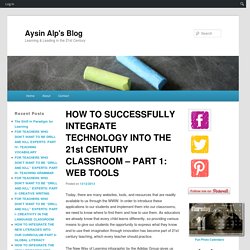
In order to introduce these applications to our students and implement them into our classrooms, we need to know where to find them and how to use them. As educators we already know that every child learns differently, so providing various means to give our students the opportunity to express what they know and to use their imagination through innovation has become part of 21st century teaching, which every teacher should practice.
21CLI - Dan Meyer - Teaching For Perplexity (5th Annual Conference) 5 Ways to Use Scannable Tech in the Math Classroom. Scannable technology can totally alter the way that you think about teaching and learning in the math classroom.
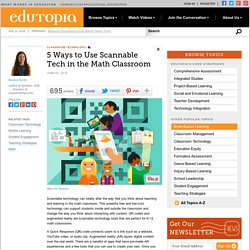
This powerful free and low-cost technology can support students inside and outside the classroom and change the way you think about interacting with content. QR codes and augmented reality are scannable technology tools that are perfect for K-12 math classrooms. A Quick Response (QR) code connects users to a link such as a website, YouTube video, or audio clip. Augmented reality (AR) layers digital content over the real world. Digital Learning Strategies ASCD Arias Ebook 2015. Assigning Digital Work. From conducting simple vocabulary practice online to leveraging multiple platforms for complex demonstrations of learning, digital tools can be used for 21st century work in many ways in our classrooms.
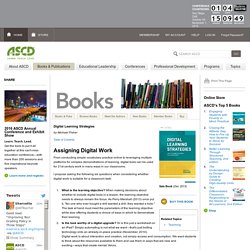
I propose asking the following six questions when considering whether digital work is suitable for a classroom task: What is the learning objective? When making decisions about whether to include digital tools in a lesson, the learning objective needs to always remain the focus. New Teachers: Technology-Integration Basics.
Toward Society 3.0: A New Paradigm for 21st century education. Connectivism. The evolution of the web from Web 1.0 to Web 2.0 and now to Web 3.0 can be used a metaphor of how education should also be evolving, as a movement based on the evolution from Education 1.0 to Education 3.0.
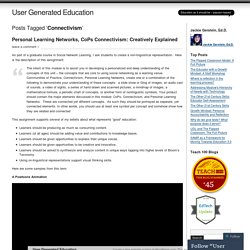
I discussed this in Schools are doing Education 1.0; talking about doing Education 2.0; when they should be planning and implementing Education 3.0. Many educators are doing Education 1.0; talking about doing Education 2.0; when they should be planning and implementing Education 3.0. Wearing Four Pairs of Shoes: The Roles of E-Learning Facilitators.
Role of the online facilitator.
Scenario A: A university professor addresses change. Scenario A: A university professor addresses change. What’s the Difference Between “Using Technology” and “Technology Integration”? Real Teaching Goes Far Beyond the Technology. When the Computer Takes Over for the Teacher — Atlantic Mobile. Whenever a college student asks me, a veteran high-school English educator, about the prospects of becoming a public-school teacher, I never think it’s enough to say that the role is shifting from "content expert" to "curriculum facilitator.
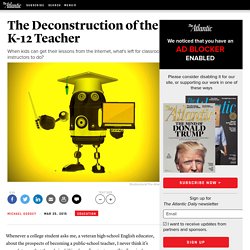
" Instead, I describe what I think the public-school classroom will look like in 20 years, with a large, fantastic computer screen at the front, streaming one of the nation’s most engaging, informative lessons available on a particular topic. The "virtual class" will be introduced, guided, and curated by one of the country’s best teachers (a.k.a. a "super-teacher"), and it will include professionally produced footage of current events, relevant excerpts from powerful TedTalks, interactive games students can play against other students nationwide, and a formal assessment that the computer will immediately score and record.
Why technology will never replace teachers. Curricula Designed to Meet 21st-Century Expectations. Alma R.
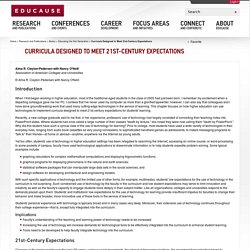
Clayton-Pedersen with Nancy O'Neill Association of American Colleges and Universities © Alma R. Clayton-Pedersen with Nancy O'Neill Introduction When I first began working in higher education, most of the traditional-aged students in the class of 2005 had just been born. Recently, a new college graduate said to me that, in her experience, professors' use of technology had largely consisted of converting their teaching notes into PowerPoint slides. Yet too often, students' use of technology in higher education settings has been relegated to searching the Internet, accessing an online course, or word-processing. Graphing calculators for complex mathematical computations and displaying trigonometric functions; graphics programs for displaying phenomena in the natural and earth sciences; statistical software packages that can manipulate large data sets in the social sciences; and design software for developing architectural and engineering models.
Implications. Next Generation Learning; Today... Over the past decade, the growth of social media has been quite remarkable.
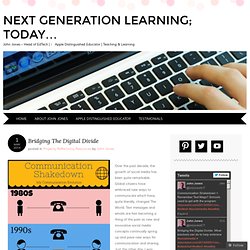
Global citizens have embraced new ways to communicate which have, quite literally, changed The World. Text messages and emails are fast becoming a thing of the past as new and innovative social media concepts continually spring up and pave new ways for communication and sharing. How to Integrate Tech When It Keeps Changing. Asking if technology enhances learning is like asking if dogs are playful.

Whether we're discussing tech or those furry mouth-breathers, the answer is the same: it depends on the situation. Here's a better line of inquiry: how do you coordinate knowledge, instructional practices, and technologies in order to positively influence academic achievement? We can begin to answer this question with the Technological Pedagogical Content Knowledge Framework (TPACK), which conceptualizes the integration of "Pedagogical Content Knowledge (PCK), Technological Content Knowledge (TCK), Technological Pedagogical Knowledge (TPK), and the intersection of all three," explains Dr. TD.5.3.4_Berk_Best_Practices_PPT.pdf. Digital Learning Day: Resource Roundup.
STEM to STEAM: Resource Roundup. Technology Integration Research Review. Editor's Note: This article was originally written by Vanessa Vega, with subsequent updates made by the Edutopia staff.
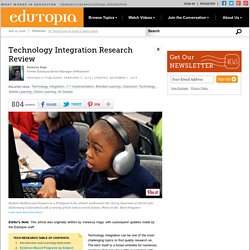
Technology integration can be one of the most challenging topics to find quality research on. The term itself is a broad umbrella for numerous practices that may have little in common with each other. In addition, technology tools change rapidly, and outcomes can vary depending on implementation. Edutopia's tech integration review explores some of the vast body of research out there and helps you navigate useful results.
In this series of five articles, learn about three key elements of successful technology integration, discover some of the possible learning outcomes, get our recommendations on specific practices and programs by academic subject and promising tools for additional topics, find tips for avoiding pitfalls when adopting new technologies, and dig into a comprehensive annotated bibliography with links to all the studies and reports cited in these pages. 12 Ways To Integrate (Not Just Use) Technology In Education.